Last Updated: 29. October 2025
There are many variations of grounded theory, each with different coding procedures and terminology. Examples include Constructing Grounded Theory by Charmaz (2006, 2014), Situational Analysis by Clarke (2005), and Grounded Theory by Glaser (1978, 1998). This guide focuses on the work of Anselm L. Strauss and Juliet M. Corbin (Strauss, 1987; Strauss & Corbin, 1990, 1998; Corbin & Strauss, 2015), who outline three coding steps:
- Open coding
- Axial coding (comparative analysis)
- Selective coding (integration)
This guide focuses specifically on axial coding, the second phase of the grounded theory coding process, and uses the coding paradigm originally proposed by Strauss (1987).
The guide is divided into two parts. Part I sets out the methodological principles and theoretical framework of axial coding within the context of grounded theory methodology. Part II illustrates the practical application of axial coding techniques using MAXQDA.
Using MAXQDA, you will be able to:
- Systematically establish relationships between your categories
- Use “Visual Tools” to develop your grounded theory graphically
- Write memos at every stage of the interpretation process
- Use AI Assist to summarize and/or brainstorm
PART I: METHODOLOGICAL BACKGROUND
1. Introduction to Axial Coding
What is Axial Coding?
Axial coding is a sophisticated qualitative data analysis technique that forms a crucial link between open coding and selective coding in the Grounded Theory Method (Corbin & Strauss, 2015). During this process, researchers systematically relate the concepts and categories developed through open coding to identify core categories, establish links between them, and develop a more comprehensive theoretical framework.
The term “axial” refers to the process of reconnecting data in new ways by forming relationships between different categories “around the axis of one category at a time” (Strauss 1987, p. 32). This network of categories is gradually and systematically built up to create a grounded theory – a theory grounded in empirical data.
During axial coding, constant comparisons are an important method for identifying the properties and dimensions of a category that influence the grounded theory: “Comparing incident against incident for similarities and differences” (Corbin & Strauss 2015, p. 239) reveals the various paths through the grounded theory model.
Therefore, axial coding provides researchers with:
- Systematic structure for organizing complex qualitative data: Axial coding offers a methodologically grounded framework for managing the inherent complexity of qualitative datasets. Rather than leaving researchers to organize hundreds of open codes intuitively, it provides clear analytical steps for grouping related concepts, identifying patterns, and establishing hierarchical relationships between categories.
- Explanation rather than mere description of phenomena: Axial coding moves qualitative research beyond the production of rich descriptions toward the development of explanatory frameworks, by systematically examining the relationships between categories.
Origin, Development, and Critique
Axial coding was primarily developed by Strauss (1987) and Strauss and Corbin (1990) as part of their systematic approach to grounded theory methodology. Their work emerged from a desire to provide more explicit methodological guidance to researchers applying grounded theory, particularly in response to critiques that the original Glaser and Strauss (1967) formulation lacked sufficient procedural clarity.
Strauss and Corbin’s (1990) conceptualization of axial coding represented a significant methodological innovation. While Glaser and Strauss (1967) had introduced grounded theory’s fundamental principles of constant comparisons and theoretical sampling, Strauss and Corbin sought to operationalize the analytic process more systematically. Their approach introduced the “coding paradigm” – a structured framework that considers phenomena, conditions, inter/action strategies, and consequences (see section 3.). This paradigm enables researchers to progress from mere description to the development of explanatory theoretical models.
It is important to note that the introduction of axial coding sparked considerable debate within the grounded theory community. Glaser (1992) criticized Strauss and Corbin's approach as overly prescriptive and argued that the coding paradigm could force data into predetermined categories rather than allowing theory to emerge organically from the data. Despite these critiques, many researchers have found the structured guidance of axial coding particularly valuable, especially those new to grounded theory methodology. The approach has been widely adopted and adapted across various disciplines, from nursing and health sciences to education and organizational studies, demonstrating its practical utility for theory development.
2. The Role of Axial Coding in the Grounded Theory Process
Relationship Between Open, Axial, and Selective Coding
The grounded theory coding process follows a systematic progression that builds theoretical understanding incrementally, moving from initial data fragmentation through analytical integration to final theoretical formulation. Understanding the distinct role of each coding phase, and particularly how axial coding functions as the crucial bridge between open and selective coding, is essential for conducting rigorous grounded theory research.
Strauss and Corbin developed a three-stage procedure that guides researchers through progressively deeper levels of abstraction and integration.
Open Coding: Open coding starts the analysis by closely examining the text, breaking data apart, paraphrasing it in relation to the research, try to identify concepts and attempting to derive preliminary categories from grouping these concepts. During this initial phase, researchers work intensively with their data. They read it line by line or paragraph by paragraph and ask what is happening and which category or property of a category a certain incident represents. The aim is to break down the data and identify as many potentially relevant concepts as possible, without imposing theoretical frameworks too early on. This process usually results in extensive lists of codes that reflect the variety present in the data.
Axial Coding: However, while open coding is necessary for detailed initial analysis, it often leaves researchers with a somewhat chaotic collection of concepts and categories that lacks clear structure. This is where axial coding becomes essential. Axial coding reassembles data by establishing relationships between categories through constant comparisons and systematic analysis. Rather than continuing to fragment data into ever smaller pieces, axial coding asks researchers to put the pieces back together in new ways that reveal patterns, connections, and causal relationships. To achieve this, the researcher will first carefully review and further develop the categories in terms of their properties and dimensions before looking for relationships between them.
Selective Coding: Following axial coding, the final integrative phase is selective coding, in which researchers refine and combine categories around one central core category to form a coherent grounded theory. This core category represents the central phenomenon to which all the other major categories can be related, resulting in a unified theoretical narrative that explains the social process or phenomenon being investigated. This core category forms the basis of the emerging theory, with the other categories supporting, elaborating on, or providing context for it.
How Axial Coding Builds on Open Coding
The transition from open to axial coding represents a fundamental shift in analytical focus and purpose. Open coding involves breaking down the data into smaller conceptual pieces and developing initial concepts and categories from these fragments. The researcher’s attention during open coding is directed primarily at the data itself: what is present, what concepts emerge, what patterns begin to appear. Axial coding, in contrast, redirects attention toward the relationships between these emergent concepts, asking how categories connect, influence, and explain one another.
Axial coding takes the categories developed during open coding and forms networks between them through systematic analysis. This process involves several interconnected analytical activities.
First, dimensional analysis explores the properties and dimensions of each category in depth. Every category possesses certain properties – characteristics or attributes that define it – and these properties exist along dimensions that represent the range of variability within each property. For example, if “professional mentorship” emerged as a category during open coding, axial coding would explore its properties such as formality (informal to highly structured), frequency (occasional to intensive), duration (short-term to long-term), and quality (superficial to deeply developmental).
Second, and perhaps most importantly, axial coding involves relational analysis: identifying how different categories influence, cause, or result from each other. This goes beyond simply noting that two categories appear together in the data. Instead, researchers systematically examine the nature of relationships between categories: Does one category serve as a condition for another? Does it represent a strategy in response to a particular phenomenon? Does it constitute a consequence of certain actions? The Strauss and Corbin coding paradigm provides a structured framework for this relational analysis (see section 3.).
Preparing Data for Selective Coding
Axial coding serves as essential preparation for the integrative work of selective coding by accomplishing several critical analytical tasks.
First, it establishes clear relationships between major categories, mapping the terrain of the emerging theory and clarifying how different conceptual elements connect. Without this relational groundwork, selective coding would lack the foundation necessary for identifying a coherent core category and integrating the analysis into a unified theoretical statement.
Second, axial coding helps identify potential core categories that could serve as the central phenomenon around which the entire analysis can be organized. Through the process of exploring relationships and applying the coding paradigm to different categories, certain categories emerge as more central, more frequently connected to other categories, or more powerful in their explanatory capacity. These categories become candidates for the core category that will anchor selective coding. The systematic analysis conducted during axial coding provides evidence for why a particular category deserves this central position rather than making this crucial decision based on intuition or preference alone.
Third, axial coding facilitates the development of preliminary theoretical propositions, statements about relationships between categories that begin to articulate the emerging theory. These propositions, developed through careful analysis of how categories relate to one another, serve as building blocks for the more fully developed theoretical statements that will emerge during selective coding.
Fourth, axial coding often involves creating visual representations of category relationships, using diagrams, maps, or models to illustrate how categories connect. These visualizations serve multiple functions: they help researchers see patterns and gaps in their analysis, they provide a means of communicating emerging insights to research teams or advisors, and they create a record of analytical development that can be referenced during selective coding.
3. The Axial Coding Paradigm
The coding paradigm itself consists of several interrelated components: causal conditions (factors that has an impact on the phenomenon), the phenomenon itself (the core category), context (the specific conditions in which the phenomenon is embedded), intervening conditions (broader structural factors that facilitate or constrain action), action/interaction strategies (purposeful responses to the phenomenon), and consequences (outcomes of those actions). This structured approach was designed to help researchers systematically “relate structure with process” (Strauss & Corbin, 1998, p. 127) and move beyond simply identifying categories to understanding the complex relationships among them.
Explanation of the Paradigm
Based on Strauss and Corbin’s approach of axial coding, researchers can use the coding paradigm to generate possible relationships between the central categories formed in the open coding process. It is introduced as a helpful tool, but “not a set of directives” (Corbin & Strauss 2015, p. 157). Therefore, you can also further develop this basic paradigm version.
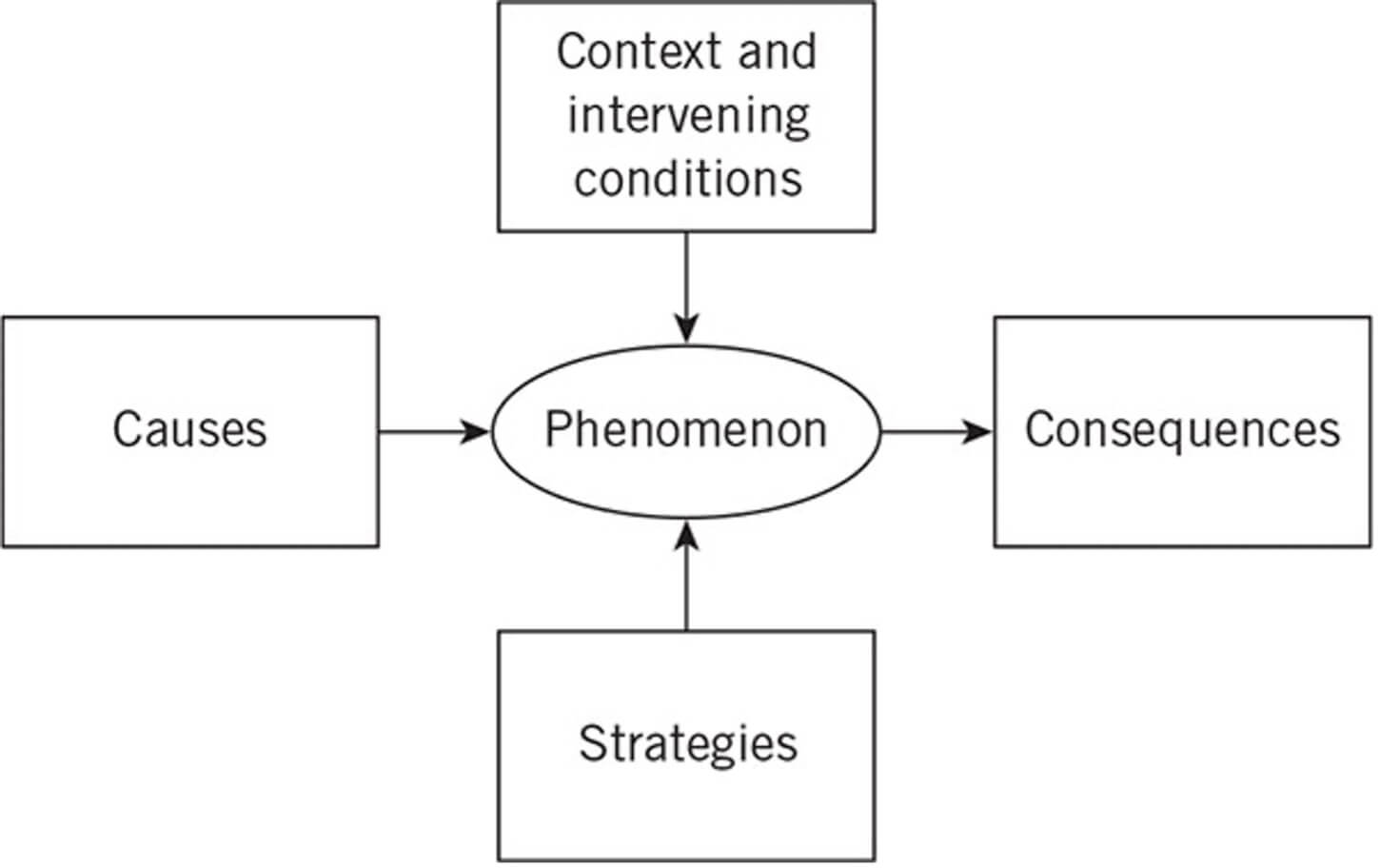
How should you read the coding paradigm? According to Strauss and Corbin, formulating a theory involves identifying if-then relationships and processes, as illustrated in the coding paradigm graphic. In short, when certain conditions coincide with particular action or interaction strategies and act on the phenomenon, different consequences or outcomes arise compared to those arising from other conditions and actions.
Components of the Coding Paradigm in detail
Central Phenomenon: This is the core category around which many or all other categories revolve. As the main theme of the research, it “must be sufficiently abstract so that it can be used as the overarching explanatory concept tying all the other categories together” (Corbin & Strauss 2015, p. 189). Therefore, the phenomenon must be able to change over time to establish if-then relationships, as indicated by the paradigm’s arrows.
Causal Conditions: These are the incidents, events or occurrences that cause a phenomenon to appear, disappear, or change. Unlike intervening conditions, causal conditions have a closer and more direct temporal influence on the phenomenon.
Context and intervening conditions: The context is the specific set of conditions within which a phenomenon occurs, especially regarding time and location. Intervening conditions are broader structural factors that characterize a person, organization, or other significant data, such as sociodemographic variables or organizational culture. They are important preconditions for strategies.
Action/Interaction Strategies: These are the goal-oriented activities that people perform, or refrain from performing, in response to a phenomenon. These strategies are often influenced by causal and/or intervening conditions. If this applies to your theory, you can add another arrow to the paradigm to link the conditions to the strategies.
Consequences/Outcomes: These consequences result from an interplay of causes, context, intervening conditions, and/or strategies. These consequences may be intentional or unintentional, and may have immediate or long-term effects.
PART II: AXIAL CODING WITH MAXQDA
This section illustrates how to carry out the individual steps of axial coding, as set out by Strauss and Corbin, using the MAXQDA software. In addition to the coding paradigm, Strauss and Corbin mention other tools in their books. For instance, Corbin and Strauss (2015) introduce the Conditional/Consequential Matrix in the fourth edition of their book (p. 163). However, to keep things simple, this guide focuses on working with the coding paradigm in MAXQDA.
4. Step-by-Step Guide to Conducting Axial Coding
Step 1: Logbook
For every grounded theory project, it is helpful to start using the logbook from the outset (main tab: ‘Home’ > ‘Logbook’). Here, you can record your research questions and objectives, as well as the most important information about your data collection. This is particularly important during the axial coding phase, as it helps to narrow down the seemingly endless possibilities for creating a network of categories.

Step 2: Reviewing categories from open coding
Before beginning axial coding, it is essential to conduct a systematic review of the categories developed during open coding. This preparatory work provides the foundation for understanding which categories are well-developed, which require further refinement, and how categories might meaningfully connect to one another.
Begin by accessing the “Codes” window in MAXQDA, which displays your complete code system in a hierarchical structure. This window serves as your primary workspace for organizing and managing categories throughout the axial coding process. Take time to familiarize yourself with the current state of your code system, noting both the overall structure and the individual categories that have emerged from open coding.
Next, review the frequency and distribution of each category by examining the numbers displayed next to each code. These numbers indicate how many segments in your data have been assigned to each category, providing valuable information about the prominence and saturation of different concepts in your dataset. Pay particular attention to categories with very high frequencies, as these may represent central phenomena worthy of deeper analysis, as well as categories with very low frequencies, which may require further development or consolidation.
As you review your categories, identify those with only a few coded segments, typically fewer than six or five coded segments. These sparsely populated categories warrant careful consideration. Ask yourself whether each represents a genuinely distinct concept or whether it might be better understood as a dimension or property of a more substantial category. Consider merging underdeveloped categories with related, more robust categories where conceptually appropriate. However, exercise caution during this process. Some categories with few coded segments may represent important outlier cases or emerging patterns that merit preservation and further investigation through theoretical sampling.
Step 3: Developing dimensional properties of categories
After reviewing the category system, it is important to develop each category in terms of its properties and dimensions. Properties are characteristics that “define and describe” (Corbin & Strauss, 2015, p. 220) categories. Dimensions are variations within properties that give categories “specificity and range” (ibid.).
For example, awareness of climate change could be relevant to a developing theory within a research project. This awareness could range from high to low. In MAXQDA, you can, for example, create a parent code for the property “level of climate change awareness” and subcodes for each characteristic of the dimension that is important for the analysis.

It is important to precisely define the characteristics of the dimension: ‘high’, ‘medium’, ‘low’. In MAXQDA, these dimensional definitions could be recorded in your code memos, providing explicit criteria that guide consistent coding decisions and facilitate deeper analysis during axial coding. To create or edit a code memo in MAXQDA, right-click on the category in the “Codes” window and select “Code Memo” from the context menu, which opens a text editor where you can document your analytical insights, dimensional definitions, and category characteristics.
Step 4: Integrating the coding paradigm into the window “codes”
Before proceeding to the next step, create a backup copy that will record the status after open coding. Then create five new parent codes that correspond to the five fields of the coding paradigm: phenomenon(s), causes, context and intervening conditions, strategies, consequences.

Use different colors for each parent code to help you keep track of them. Next, drag and drop each of the categories you developed during open coding onto one of the five parent codes in the “Code” window to allocate them to one of the five paradigm fields.
Step 5: Creative Coding
For more complex projects, use the Creative Coding tool to allocate categories to one of the five parent codes. Creative Coding is a useful tool for organizing and structuring codes. You can find it in the “Codes” menu tab.
In the Creative Coding mode, you can see a workspace with the current code system on the left panel and a blank canvas on the right. In a first step, drag the five new parent codes representing the coding paradigm on the canvas and try to arrange them as far apart from each other as possible. In a second step, drag the most important categories from the open coding on the canvas next to the parent code it may belong to.
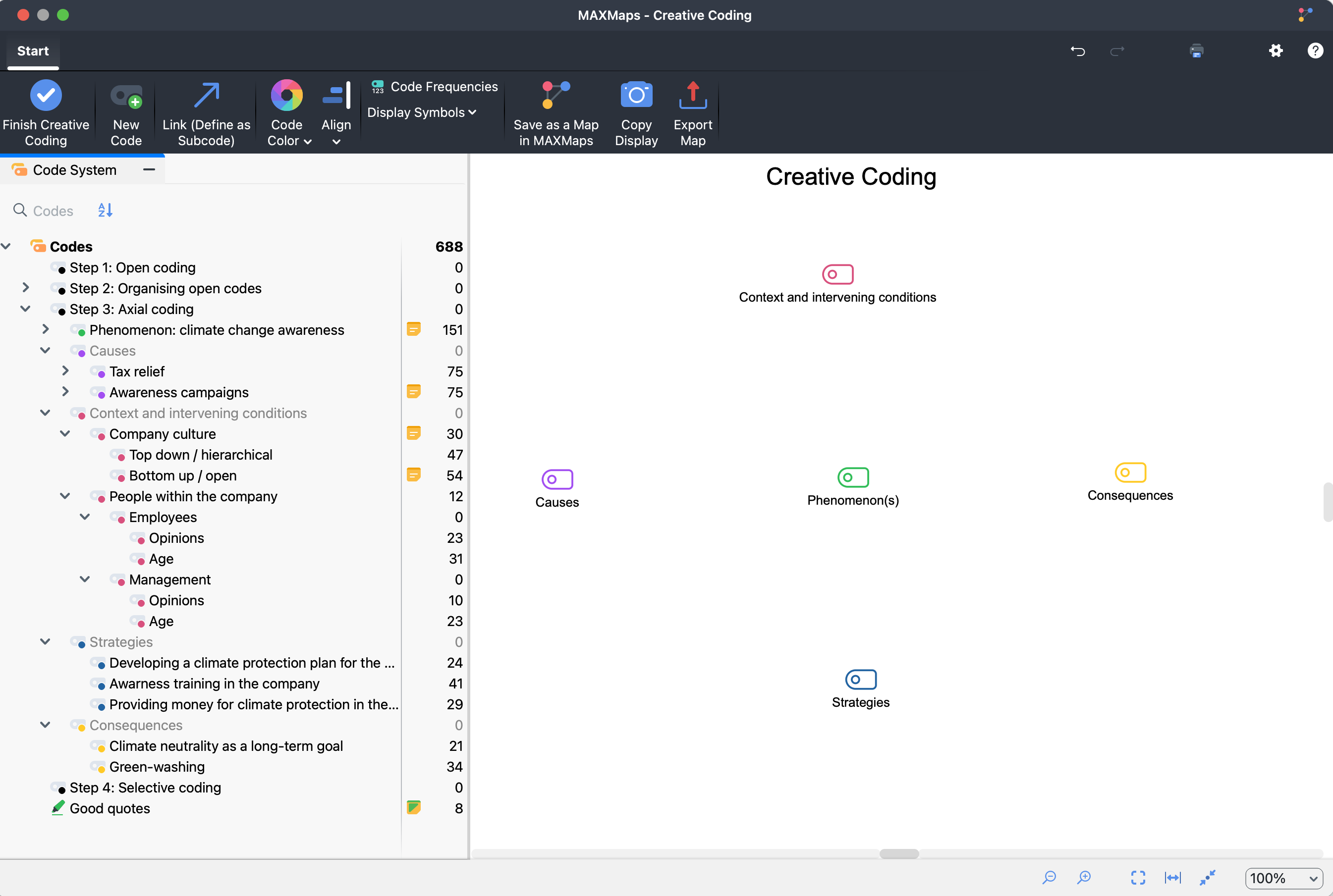
Once you have finished, check that your assignments are correct. Then switch to Link mode by clicking the “Link (Define Subcode)” icon on the Start Menu tab. Click on the intended parent code and drag an arrow to the category to assign it.
If you find that some categories, properties, or dimensions are too small, you can merge them in Creative Coding mode. Simply drag one category onto another, holding down the mouse button, and release it when the “Merge codes” tooltip appears.
Once you have assigned categories to all five parent codes, click the “Finish Creative Coding” button in the top-left corner. You will then be asked to confirm that you want to make these changes. Click “Yes”, if you are sure. Your changes will then be transferred to the “Codes” window.
At this stage, some categories will usually remain unassigned to any of the five parent codes. Therefore, create an “Other” category in the “Codes” window and group these together, for instance with the green plus icon in the “Codes” window’s header. This will allow you to access them again later.
Step 6: Using MAXMaps for Axial Coding Visualization
In addition to assigning all categories to one of the five parent codes in the “Codes” window, use MAXMaps to see the possible connections between categories visually.
MAXMaps is designed to provide a visual representation of the various MAXQDA elements (codes, documents, memos, and coded segments) within a workspace known as a map' illustrating their relationships. It is an invaluable tool for visualizing and developing theoretical relationships in axial coding.
First, open MAXMaps via the “Visual Tools” tab and create a new map by selecting “Start”. Next, use the “Insert” tab to draw the coding paradigm. During this process, select “New text” and enter one of the five fields. Then, use the arrow icon to indicate the relationships between them. To help you remember the main research question, add it to the map too.

Next, drag all the relevant categories from the “Code” window onto the map canvas. Since you have already assigned them to one of the five fields, this process should now be quicker and clearer.
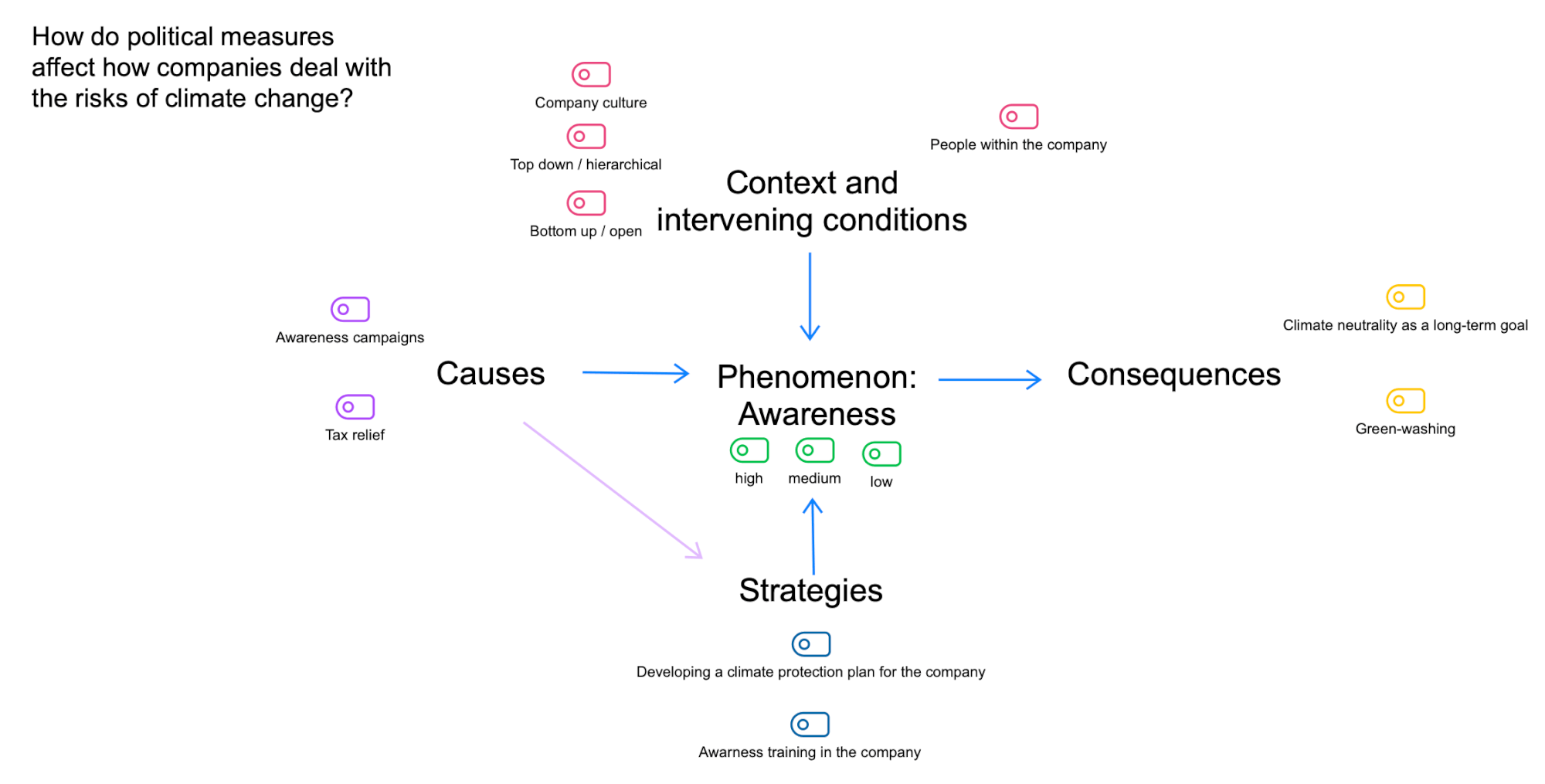
Alternative possibilities: You could also use a model template in MAXMaps for this step, for instance the Code Theory Model.
Step 7: Constant Comparisons
You now have everything you need to carry out constant comparisons. With MAXMaps, you can think graphically about which dimensions of a property to compare, helping you to identify the conditions and strategies that impact your phenomenon and lead to certain consequences, and those that do not. MAXQDA also provides other tools that assist in comparing: Interactive functions of MAXMaps, Segment Matrix, Memos, and Loogbook.
MAXMAps: Interactive functions
All the elements used in a MAXMaps are interactive, meaning they are connected to the MAXQDA project. This makes an icon that symbolizes a category not only a passive icon but allows you to double-click on the icon to open all coded segments assigned to this category in a new window.
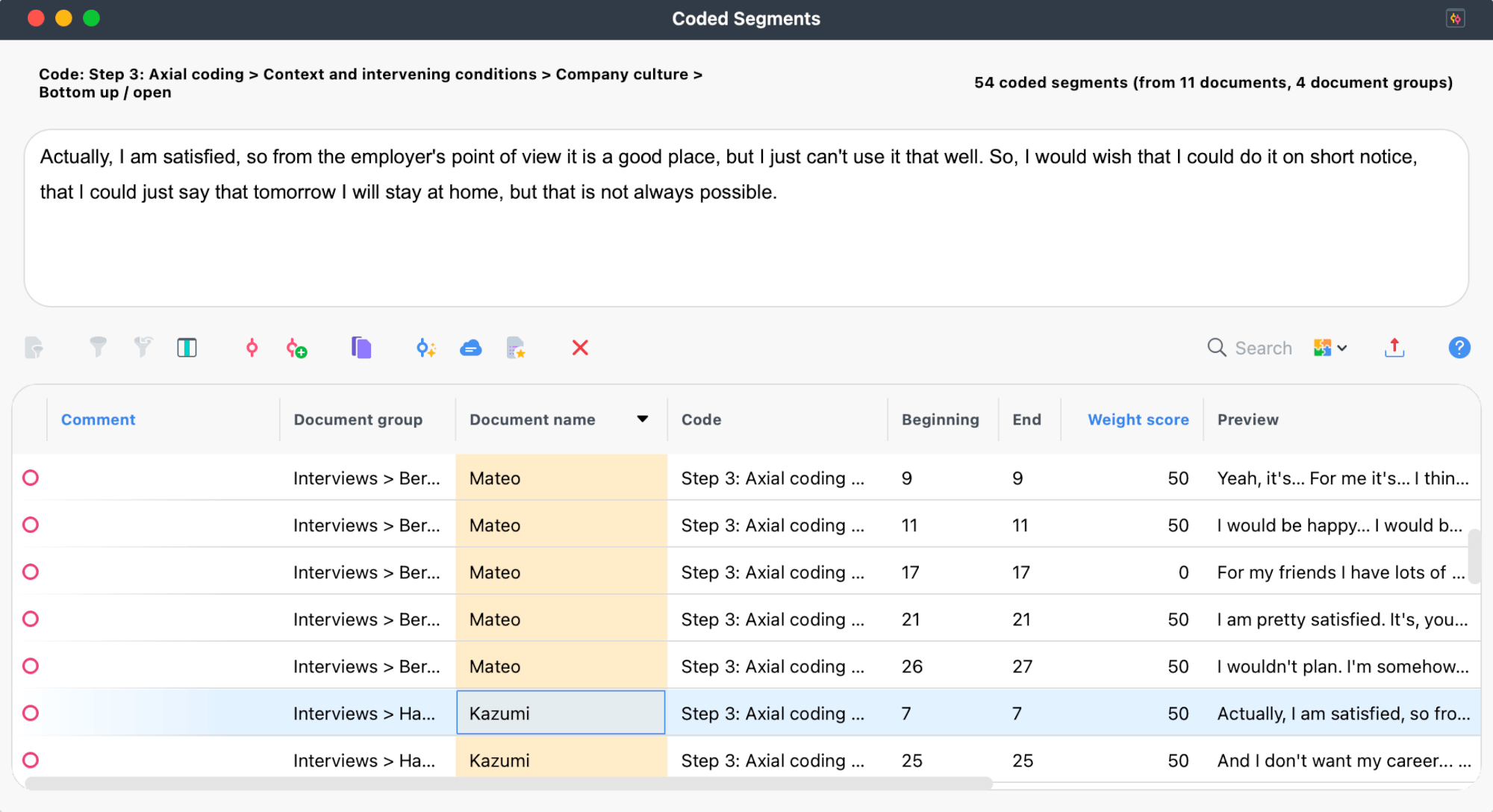
Double-clicking on one of the coded segments forwards you to the Document Browser, where you can read the segments in context. This ensures that you never lose the connection to the original data when establishing links between categories in axial coding.
Segment Matrix
To make detailed comparisons, use the segment matrix in the “Mixed Methods” tab. First, create document groups in the “Documents” window. Then use this tool to compare the different groups.
For example, you might want to compare people living in Berlin with those living in Hamburg to find out to what extent place of residence has in influence in your grounded theory. Create two document groups and use drag-and-drop to assign all interviews to the appropriate group.
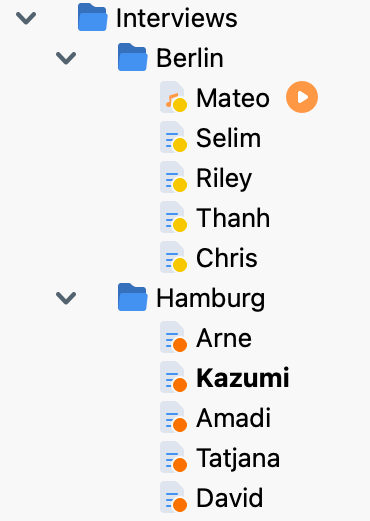
Then open the “Segment Matrix” tool. In the first window, click on “Document Group” and then on the blue arrow. Next, select Hamburg from the drop-down menu in the bottom right-hand corner. Do the same for Berlin, then click “OK”.
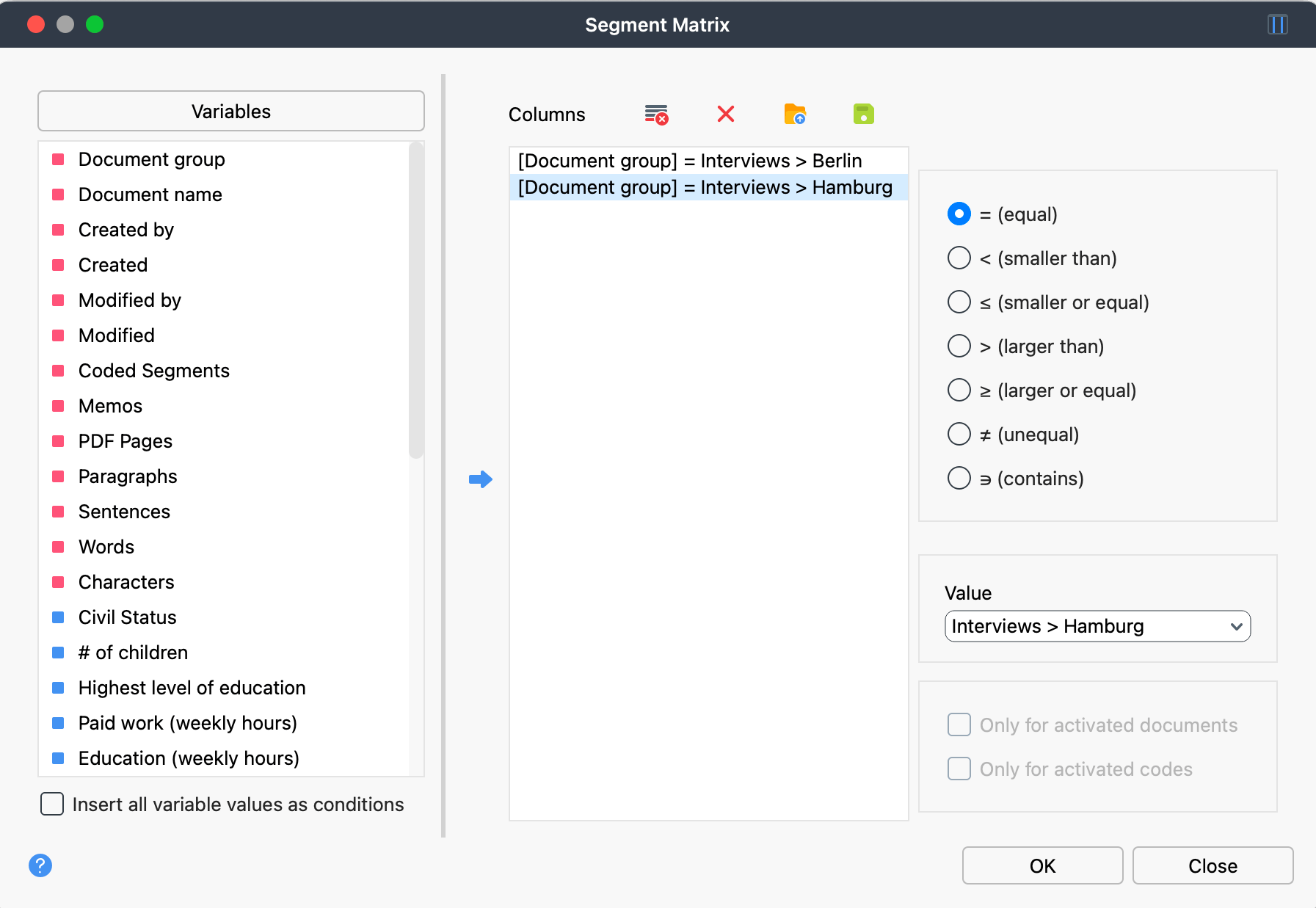
Your category system will then be displayed on the left of the next window, along with all the coded segments of each category, divided by place of residence and spanning all interviews.
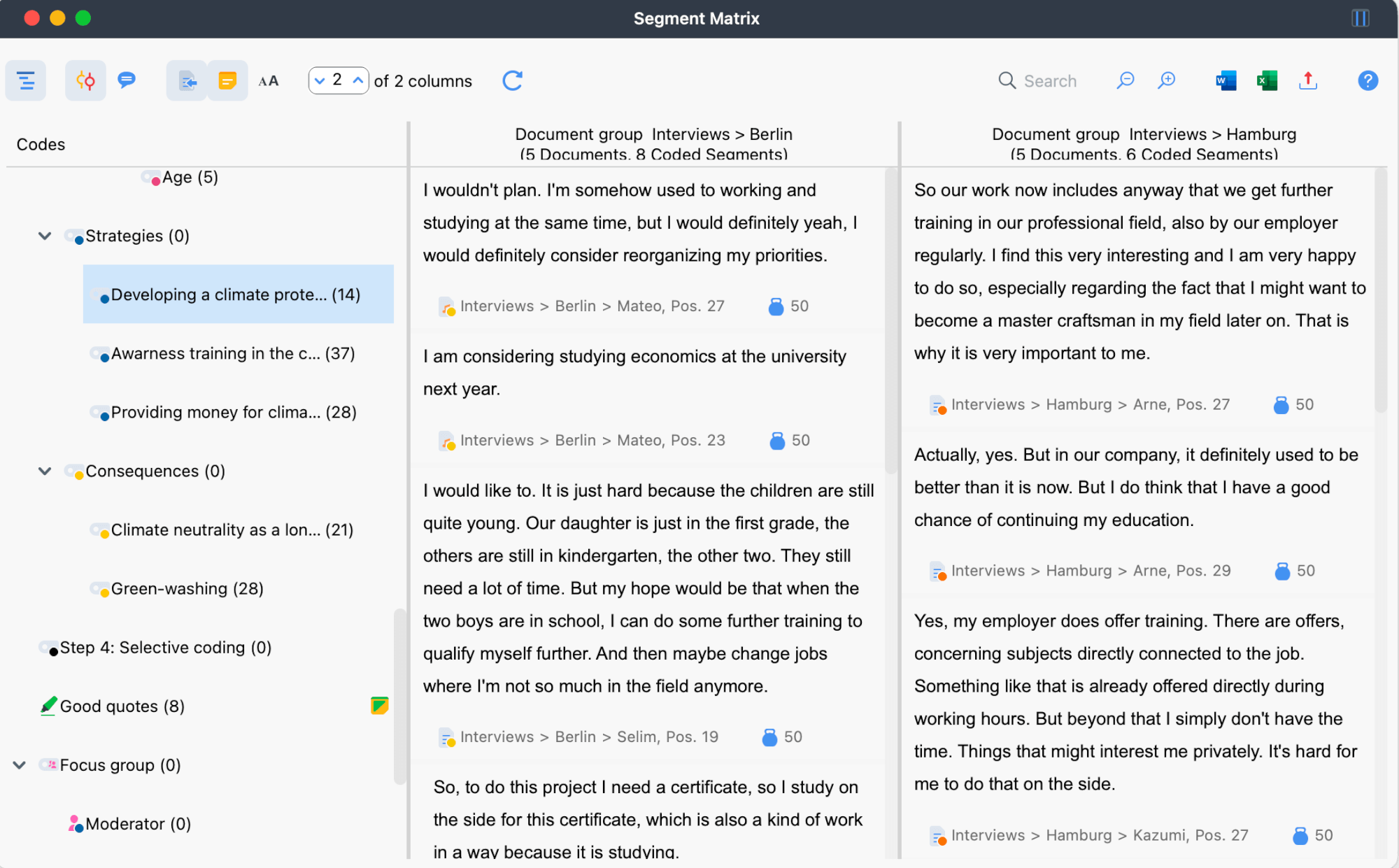
This procedure makes it possible to read all the content from people in these two cities in parallel, compare it, and look for similarities and differences.
Memos and Logbook
The most important findings of constant comparisons can be recorded in memos or in the logbook. In the logbook, you can list all comparisons carried out and briefly note the actions taken and the results achieved. Memos can be used in a variety of ways. In this phase of axial coding, for example, code memos can be used to summarize the most important findings per category. You can use the Code Summary field for this purpose. You can also link the memo to codes and / or coded segments.

To establish connections between categories and fields, I recommend creating a free memo in the “Memo” main tab. Unlike the logbook, these are not linked to specific elements in MAXQDA, but they are useful for recording general notes on analytical thoughts and connections.
5. What happens next?
Selective Coding
In the subsequent selective coding phase, all previous models are integrated into one new model at an even more abstract level. The axial coding tools discussed above, such as Creative Coding and MAXMaps, can be used for this purpose too.
At the end of the axial coding phase, ideally the most important relationships between individual categories have been established, their properties / dimensions compared with each other, and it has been determined which aspects influence each other and how individual aspects are related. But often, it is not possible to create just one model based on the coding paradigm in a first step. Instead, two or three models are usually created in the initial axial coding phase.
Theoretical Sampling: Collecting additional data
In some cases, additional data must be collected during axial coding if a comparison is not fully possible or if certain categories remain underdeveloped. This corresponds to the interactive process of grounded theory, in which data collection and analysis often alternate to form a theoretical model—a process known as theoretical sampling.
Theoretical sampling is a distinctive feature of grounded theory methodology wherein the researcher deliberately seeks new data sources, participants, or contexts based on emerging analytical needs rather than predetermined sampling criteria. For instance, if during axial coding a researcher identifies an important causal condition but has insufficient data to understand how it operates across different contexts, they would strategically collect additional data specifically addressing this gap. This might involve conducting follow-up interviews with participants who have experienced certain conditions, seeking out cases that represent different dimensional extremes, or exploring contexts where the phenomenon manifests differently. The goal is to develop categories until they reach theoretical saturation –the point at which new data no longer reveal additional properties or dimensions of a category.
Overall, it can be said that iterative work is carried out primarily during the open coding phase, decreasing continuously during the axial and selective coding phases. This progressive reduction in iterative activity reflects the increasing theoretical clarity and integration achieved through systematic analysis, though it is important to note that grounded theory remains fundamentally flexible, allowing researchers to return to earlier coding phases if significant new insights emerge.
QTT workspace
For getting a good overview, you could also use the QTT workspace (Questions – Themes – Theories) for summarizing all findings.
In the QTT work environment, you can formulate research questions, collect key categories and memos, save visualizations, and write summaries. Using different QTT worksheets for open, axial, and selective coding may be useful.
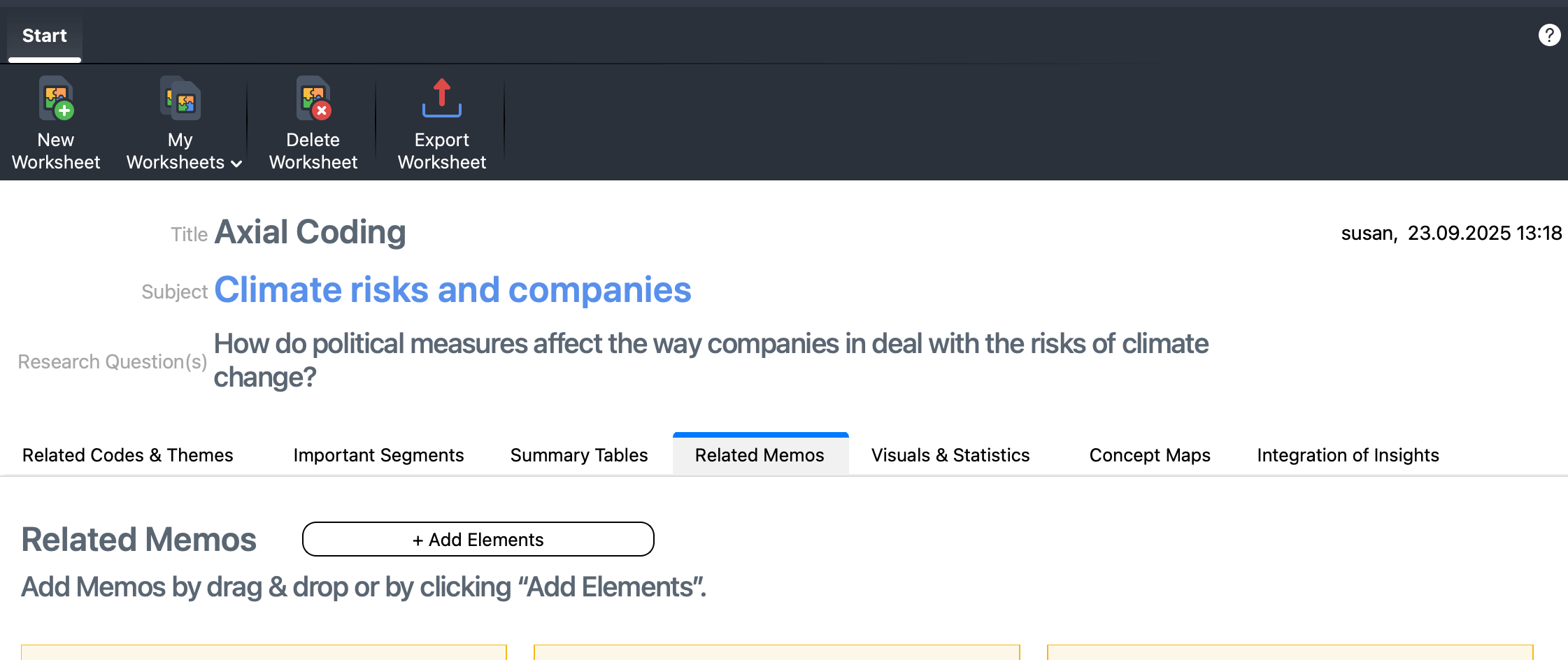
6. Writing the report (with a short example)
When writing the report, it is advisable to start with presenting the model that was created during the selective coding process and describe the categories and their properties. A screenshot from MAXMaps is also suitable for this purpose (see Figure “MAXMAps: Coding paradigm with categories”).
You can then present the typical combinations of categories and paths through the model. For example, you could show that different combinations of conditions and strategies lead to different consequences.
Imagine we are carrying out a project with the following main research question: How do political measures affect the way companies deal with climate change risks? Our analysis shows that the phenomenon at the core of our grounded theory is awareness of climate change, ranging from high to low. We also identify and describe two typical paths through our model.
Path 1: In regions where policies have raised awareness of the risks of climate change through campaigns and workshops (causal conditions), companies are more likely to have a high awareness of climate change risks (phenomenon) than in regions where policies have provided tax relief. Consequently, when politicians raise awareness, companies are also more likely to raise awareness within their own organization and develop a climate protection plan (strategies). As a result, these companies have made climate neutrality a long-term goal (consequence).
Path 2: By contrast, companies in regions where politicians offer tax relief in exchange for implementing climate measures (causal conditions) tend not to provide their employees with climate awareness training within their company (strategy). However, they do spend money on implementing a few climate measures (strategy). This results in lower awareness of the risks of climate change among these companies (phenomenon), and consequently greenwashing rather than climate neutrality as a long-term goal (consequence).
7. Advanced Techniques
Using AI Assist for Axial Coding
MAXQDA AI Assist can act as a dedicated research assistant, carefully identifying relevant text passages and assigning them to specific codes. For axial coding, AI-Assist can help by:
- Analyzing coded segments to identify patterns within categories
- Summarizing category content to clarify conceptual boundaries
- Suggesting relationships between different categories
- Identifying gaps in your analytical framework
Code Relationships Browser
Use MAXQDA’s Code Relationships Browser to:
- Identify co-occurring codes that may belong in the same category
- Discover unexpected relationships between categories
- Quantify relationship strength through co-occurrence frequencies
- Generate Code Maps that visualize code relationships
Integration with other MAXQDA Tools
- Code Matrix Browser: Compare how categories manifest across different documents or cases
- Summary Grid: Create systematic comparisons of category content
8. References
Charmaz, K. (2006). Constructing grounded theory. SAGE.
Charmaz, K. (2014). Constructing grounded theory (2. Aufl.). SAGE.
Clarke, A. E. (2005). Situational analysis: Grounded theory after the postmodern turn. SAGE.
Corbin, J. M., & Strauss, A. L. (2015). Basics of qualitative research: Techniques and procedures for developing grounded theory (4. Aufl.). SAGE.
Glaser, B. G. (1998). Doing grounded theory: Issues and discussions. Sociology Press.
Glaser, B. G. (1992). Basics of grounded theory analysis. Sociology Press.
Glaser, B. G. (1978). Theoretical sensitivity: Advances in the methodology of grounded theory. Sociology Press.
Strauss, A. L. (1987). Qualitative data analysis for social scientists. Cambridge University Press.
Strauss, A. L., & Corbin, J. M. (1990). Basics of qualitative research: Grounded theory procedures and techniques. SAGE.
Strauss, A. L., & Corbin, J. M. (1998). Basics of qualitative research: Techniques and procedures for developing grounded theory (2. Aufl.). SAGE.
About the author

Dr Susanne Sackl-Sharif is a sociologist and musicologist based in Austria. She has worked with MAXQDA software since 2009, using it to carry out many qualitative and mixed-methods projects. Since 2014, she has also been involved in academic coaching, supporting students and researchers with their MAXQDA projects. For further information see www.sackl-sharif.net.
